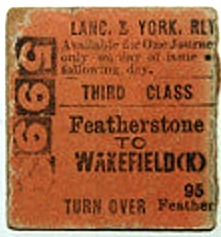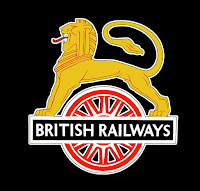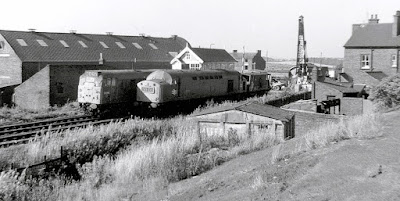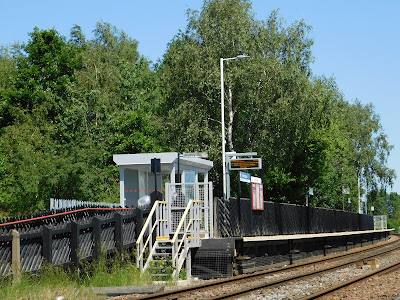FEATHERSTONE STATION
1848
A Railway line from Wakefield to Goole was proposed in 1844 by the Wakefield, Pontefract and Goole Railway Company and sanctioned in 1845. The company was taken over by the Manchester and Leeds Railway Company in 1846, and then by the Lancashire and Yorkshire Railway Company in 1847. The line was opened in 1848.
Featherstone Station was only a simple halt with a small signal box to control the gates and a few signals, two short plain platforms, and a station house. It was built in open ground halfway between (North) Featherstone, population 347, and Purston, population 268 in the 1851 census. This map of the original station is from the Ordnance Survey of 1849.
Featherstone Station was only a simple halt with a small signal box to control the gates and a few signals, two short plain platforms, and a station house. It was built in open ground halfway between (North) Featherstone, population 347, and Purston, population 268 in the 1851 census. This map of the original station is from the Ordnance Survey of 1849.
1858
A goods yard was soon added. A newspaper report of an accident mentions the points for the goods yard.
1863
It was possible to get to London by changing at Knottingley. During the week the train left Featherstone at 8.13am and arrived in London at 3.30pm. On Sundays it was 10.47am arriving at 7.45pm.
1873
A goods train from Leeds to Doncaster was passing Snydale Colliery when an axle on one of the wagons broke, and several wagons were derailed strewing their contents in all directions and blocking both lines. Breakdown gangs cleared one line to allow trains to run and then spent hours clearing the other line.
1877
A man fell from the 8.30pm train at the station and sued the railway company. He said the station was badly lit with only one oil lamp covered with dust.
A letter in the Leeds Mercury complained about the dismal flicker of the oil lamps at Featherstone Station and urged the company to install gas lighting. (The local gas company was formed in 1873.)
1882
At a Local Board (Council) meeting Mr Andrew said it was 34 years since the railway was opened. At that time the houses from the Went Beck to Old Featherstone could be counted on the fingers of one hand. Now the population was ten times greater at 4,000. In spite of this nothing had been done had been done on the north platform of the station for the accommodation of passengers in inclement weather. The Board agreed to write to the railway company.
At a later meeting it was said 150 miners were kept waiting half an hour at the station level crossing at 5.30am while a goods train was shunted. It made them late for work, and it was suggested a subway should be built.
1883
James Umpleby of the Railway Hotel was charged with permitting drunkenness. The market train from Pontefract arrived at Featherstone at 9.30pm carrying some passengers who had already had too much to drink. They made a rush for the Railway Hotel. Supt Whincup told the court on many occasions he had had to detail officers to await the arrival of the train to protect the station master and the landlord. The Bench said under the circumstances they would be lenient and not endorse his licence.
1885
The Lancashire and Yorkshire Railway Company announced they were to widen the north platform of the station and build a porters room and toilets. It was not intended to erect a shelter for passengers.
Two special trains conveyed 999 people connected with Featherstone Main Colliery on a trip to Scarborough.
1889
George Bradley refused to sell the land needed for improvements to the station. The railway company said it was applying to Parliament for powers to obtain the land, and a footbridge would be built. The Local Board said it still preferred a subway and they would oppose the Bill if necessary. The company asked if the Local Board would pay the extra cost of £250 for a subway and the Board said no.
Some people tried to work a fiddle by buying a single ticket to Tanshelf Station and only handing half in when they got there. Then when they returned after dark they handed the other half to the ticket collector hoping it would not be detected. The collectors soon realised what was going on, and one man was arrested and fined 10s as a deterrent to others.
1890
A census was taken at the Station Lane level crossing, and in six days 29,125 pedestrians and 1,010 carts crossed the lines. The railway company gave way and said they would have a subway if the Local Board would cover the cost of draining it. It would have to be at the station side to connect the platforms so that passengers would not have to cross the lines. The Local Board would not agree. They wanted the subway at the Pontefract side where the footpath was (there was no footpath at the station side). Eventually the Local Board gave way. This postcard show the station before the subway was built.
1891
There was a concessionary fare of 7d return to Wakefield by one train only. The company decided to extend it to five trains a day. The enlarged photo of a ticket is from the Featherstone Heritage Group.
1892
The schools were overcrowded so the Government Education Department said a new school should be built at the north side of the station and provision made for the safety and no delay to the children at the station level crossing. The Local Board sent this directive to the railway company and it gave them the final push to get on with the promised improvements. They gave a contract to Meesrs Leake and Sons of Normanton to build a subway, a new booking office, waiting rooms and extend the platforms. The postcards below show the subway canopies from two view points.
1893
A goods train was waiting in the station when another goods train ran into it causing wagons to pile up to a great height. Australian beef and mutton was scattered all over the track. The accident happened at 10pm in thick fog, and it took five hours to clear the line.
1895
The local tradesmen had to arrange their own transport from the goods yard. They complained, because from the Wakefield and Pontefract stations goods were delivered to the traders door. The railway company said the trade at Featherstone did not warrant the expense of delivery staff, and the prices charged took this into account.
1898
After a number of deaths over the years at the Church Fields level crossing (the one on the path from Featherstone Lane to Purston) The Council asked the Lancashire and Yorkshire Railway Company to install a subway. The company said there was a good view in both directions, but if the Council wanted to install a subway they would give every assistance. The Council let the matter drop.
1903
Many Pontefract miners walked down Halfpenny Lane to and from their work at Featherstone's pits. The Lancashire and Yorkshire Railway Company said they were considering erecting a footbridge at the Halfpenny Lane level crossing at a cost of £400, and would Pontefract Corporation and Featherstone Council share the cost. The Council refused and said they would prefer a road bridge. The Express commented a subway would be better.
1905
During shunting operations near the Middle Lane crossing the engine driver went too fast and hit the buffers. Eleven wagons were strew across the main lines and until they were cleared railway passengers had to leave a train on one side, walk past the smash and board a train at the other side.
1906
The 1905 smash caused the railway company to find a way to get wagons in and out of Ackton Hall Colliery without disruption to the main lines. There were already four tracks past Snydale Colliery and the idea was to continue these to past the Halfpenny Lane level crossing. This would mean widening the Commonside Lane bridge, moving back the north platform at the station, a footbridge at the Church Fields level crossing, and a road bridge at the Halfpenny Lane crossing.
In the end it was decided this wasn't practicable, and the only part of the plan put into operation was the widening of the bridge, and four tracks which went back into two at the station. Also a connection was made from the main line to the colliery empty wagon sidings to the east of Station Lane. The photo, from the Wakefield Libraries Collection, shows the Ackton Hall Colliery full wagon sidings and the four track mainline as seen from Commonside Lane bridge.
This third Wakefield Libraries Collection photo show the primitive buffer stop at the end of the station north platform.
A structure was put up on the north platform to provide a shelter for passengers. The Council wrote to the company saying they did not thank them for putting up a cowshed. This postcard shows the controversial shelter.
1911
There was a national strike over union recognition and wages which only lasted two days. There were about 20 men involved at Featherstone Station and on the first day two refused to strike. One was persuaded but the other continued working. No trains ran and the goods yard was closed. Although of short duration the strike caused a serious shortage of empty wagons at Ackton Hall Colliery for five days.
1913
The connection from the main line to the Ackton Hall Colliery's empty wagon sidings caused long delays to people using the Church Fields level crossing. The Council complained and the railway company said they would look into the matter. The Council tried to get the Board of Trade involved in the idea of a footbridge or subway but the Board said they did not have any statuary powers for that. This Ordnance Survey map shows the connection. The railway cottages are bottom left, and the Church Fields (cricket field) level crossing is just off the map at top right. The cricket ground shown is an old one between the Rovers pitch and the railway lines. The connection lasted a long time because it is shown on maps dated from 1905 to 1948.
1914
On a dark night in January at 9.40pm the station gates were closed. A taxi came up Station Lane, crashed through the gates, and hit the engine that was just passing. The Lancashire and Yorkshire Railway Company sued for damages, and the taxi owners, Smith and Son of Doncaster, counter-sued claiming the lamp on the gates was not lit. After hearing much conflicting evidence the judge decided in favour of the railway company.
1915
The Council was concerned about overcrowding on the north platform. They wanted two ticket collectors to be used and both gates opened, the left hand one gave direct access to Station Lane north of the station, and the right hand one gave access to the subway. The railway company refused. The photo is from a postcard.
1919
The carting agents who moved the goods from the station wanted the dock and warehouse accommodation improved. Mr H Marriott, chief goods manager for the railway company, arrived to see the Council and was told of the great need for better accommodation at the station, a goods delivery established, and subways at the level crossings. Mr Marriott promised to report to his directors, but pointed out the railways were still in the hands of the Government who had taken them over during the war, and he could not commit his directors. The eventual answer was the usual reply, a no to everything.
There was a nine days national rail strike. The first train to arrive was only an engine and guard's van, and there was a soldier on the footplate. The station gates were operated by the stationmaster and a policeman. The collieries were affected by a shortage of empty wagons.
1922
The Lancashire and Yorkshire Railway merged with the London and North Western Railway, so the local engines' logo was changed. The L & Y train is from Locomotives of the Lancashire and Yorkshire Railway on the internet, and the LNWR engine is from Grace's Guide.
With a new company now in charge the council tried again about the Church Fields and the Halfpenny Lane level crossings. The answer was still the same. There was a clear view of the lines at both crossings, and with care there was no more danger that with street traffic, therefore there would be no subway or foot bridge.
1923
There was another amalgamation of railway companies which resulted in the London Midland and Scottish Railway being formed. The photo is from Locomotives of the London, Midland and Scottish Railway on the internet.
The Council tried yet again with this new company regarding the level crossings, and once more were rebuffed. A census was taken which showed about 40 person a day used the Church Fields crossing, and 500 a day used the Halfpenny Lane crossing which rose to 800 on Sundays. The Board of Trade told the Council there was no statutory obligation on the LMS to provide a bridge or subway at the level crossings, and they would have a better case if they could prove delays due to shunting coal wagons.
1924
A deputation went from the Council to London to discuss with the London, Midland and Scottish Railway Company the problems at the level crossings. The Council offered to pay half the cost and the company said two footbridges would be erected as soon as their engineers could do it. The Council said a subway at the Church Fields crossing was preferred and the company said it would be considered.
At the next Council meeting some members pressed for a subway, but the majority voted in favour of footbridges. The LMS then said they would require the footpath rights over the crossings to be abolished. This would cause difficulties for bicycles and prams so the Council abandoned the idea of footbridges and would ask for a subway at Church Fields crossing.
1948
The railways were nationised and Featherstone Station became part of British Railways. So the logo was changed yet again.
1958
The passenger trains in the district around Featherstone were changed from steam trains to diesel passenger units. Those that came through Featherstone had B3 on the front, although the photo is from the North Norfolk Railway.
1963
British Rail was running at a loss each year, and something radical had to be done. Richard Beeching was appointed to examine the network and come up with a solution. Among his proposals was the closing of 2,363 stations including Featherstone.
The freight depot at the station was closed, and the railway motor collection and delivery services were transferred to Monkhill Station, Pontefract.
1965
Along with all the changes British Railways changed to British Rail.
1966
The Ministry of Transport decided the passenger service from Wakefield to Tanshelf would be ended and the stations, including Featherstone, closed.
1967
The stations at Featherstone and Tanshelf were closed on 2 January.
1968
British Rail were planning to replace the Station Lane crossing gates by lift up barriers. They asked the Council if they could replace the subway and provide wicket gates at the same time. The Council refused, so the superstructure was removed. The photos of people waiting at the new style barrier and the subway with the superstructure gone are by Dr J Gatecliff.
Although closed to normal passenger traffic, the station was still used for special trains for events such as football games or seaside trips. This working men's club trip to Bridlington left the station on 9 July. Photo by Mark Walker (Flickr).
1970
British Rail announced the disused buildings at Featherstone Station would be demolished as part of a tidying up operation. The Council were asked to provide a house for the family who lived in the station house.
1972
There were delays at the Station Lane level crossing. There were claims the barriers were down for nearly half-an-hour on occasions. Cr J W Bettridge said the position was chaotic. Cr J H Livesey said British Rail would realise eventually these incidents would not be tolerated. Photo by Dr J Gatecliff.
1975
Now Featherstone Council had been taken over by Wakefield MDC, British Rail applied again to abandon the subway, but the new council also refused.
1976
British Rail tried once again to dill in the subway, but again the Council refused and asked for it to be repaired because it was unlit and flooded when it rained. The company gave in and carried out renovation works. Photo by Alan Walker.
Photo by Alexander Lanes.
1992
This photo by Dr J Gatecliff shows the site of the original station just before the new one was constructed.
Passenger services between Wakefield and Pontefract were reinstated by West Yorkshire Metro on 12 May 1992. The new Featherstone Station was just two platforms with no buildings. The platforms were staggered at each side of the level crossing. The photo of the north platform is by Ben Brooksbank (Geograph) and that of the south platform is by Dr J Gatecliff.
2021
The Flying Scotsman engine pulling an excursion train passed through Featherstone Station. Photo - Joe Lyman.
THE HALFPENNY LANE CROSSING
Halfpenny Lane was historically a track for walkers and farmers between Featherstone and Pontefract. So when the Wakefield to Goole railway line crossed it in 1848 there had to be a level crossing. This photo taken from the railway lines after a heavy snowfall and showing the farmers' gate and the road back to Cressey's Corner is from the Dr J Gatecliff Collection.
There was a gatekeeper's cottage next to the crossing. This photo is also from the Dr Gatecliff Collection.
For some years at the beginning of the 20th Century there was talk of making Halfpenny Lane into a proper road and possibly bringing Pontefract trams to Green Lane. But Featherstone Council and Pontefract Corporation couldn't agree on a project so it didn't happen, but the seller of land near the crossing thought it would.
The Council made a clearance order in 1972 for the old properties in the Halfpenny Lane area near the crossing, which meant the end for the gatekeeper's cottage. It was said to be the last house in Featherstone to still have a privvy.
The Dr J Gatecliff photo below taken in 1977 shows a new property near where the cottage used to be. The level crossing was still wide enough for farm vehicles but was unlikely to have been used.
Bill Henderson (Geograph) took this photo of the Pontefract side of the crossing in 2014.
The photos of both platforms taken in 2021 are personal.








































